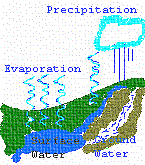The Water Cycle

- Water vapour in the atmosphere condenses and falls as rain or
snow
- This water flows either above ground in
rivers or streams or below ground
- Some evaporates back into the atmosphere
- The remaining water reaches lakes and, eventually, the oceans,
which again can provide water vapour through evaporation
The amount of water available is an important factor in determining what
type of vegetation an area can support. Water also shapes the land
through erosion and flooding, moving material
from one location to another. Water also had a dramatic effect on
the continents in the form of glaciers,
huge masses of ice which depressed the earth's crust.
Wetlands such as
provide natural water flow management by providing interim storage for
excess water. Wetlands also help purify water: water dissolves almost anything
which leaves it open to contamination.
Although there is a lot of water on the planet, much of it is either
difficult to use (ocean water) or difficult to
retrieve (underground water). Even in large bodies of water like
the Great Lakes, only a relatively small amount
is renewable through rainfall or runoff.
For More Information
![[home]](gsbann.gif)

![[home]](gsbann.gif)